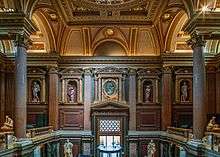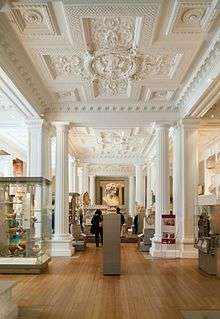Fitzwilliam Museum
 The main entrance to the Fitzwilliam Museum, facing Trumpington Street. | |
 Location in Cambridge | |
| Established | 1816 |
|---|---|
| Location | Cambridge, United Kingdom |
| Coordinates | 52°12′01″N 0°07′10″E / 52.200278°N 0.119444°E |
| Type | University Museum of fine art and antiquities |
| Collection size | approx. 550,000 |
| Visitors |
470,000 (2011–12) [1] |
| Director | Tim Knox |

The Fitzwilliam Museum is the art and antiquities museum of the University of Cambridge, located on Trumpington Street opposite Fitzwilliam Street in central Cambridge, England. It receives around 470,000 visitors annually (2011–12).[1] Admission is free.
The Museum is the lead museum for the University of Cambridge Museums consortium, one of 16 Major Partner Museum services funded by Arts Council England to lead the development of the museums sector.[1] The current Director of the Fitzwilliam Museum is Tim Knox.
Foundation & buildings

The museum was founded in 1816 with the legacy of the library and art collection of the 7th Viscount FitzWilliam. The bequest also included £100,000 "to cause to be erected a good substantial museum repository". The collection was initially placed in the old Perse School building in Free School Lane. It was moved in 1842 to the Old Schools (at that time the University Library). The "Founder's Building" itself was designed by George Basevi, completed by C. R. Cockerell and opened in 1848; the entrance hall is by Edward Middleton Barry and was completed in 1875. The first stone of the new building was laid by Gilbert Ainslie in 1837. A further large bequest was made to the University in 1912 by Charles Brinsley Marlay, including a sum of £80,000 and a collection of 84 pictures. A two-storey extension, paid for partly by the Courtauld family, was added in 1931.[2]
Collection

The museum has five departments: Antiquities; Applied Arts; Coins and Medals; Manuscripts and Printed Books; and Paintings, Drawings and Prints. Together these cover antiquities from Ancient Egypt, Sudan, Greece and Rome, Roman and Romano-Egyptian Art, Western Asiatic displays and a new gallery of Cypriot Art; applied arts, including English and European pottery and glass, furniture, clocks, fans, armour, Chinese, Japanese and Korean art, rugs and samplers; coins and medals; illuminated, literary and music manuscripts and rare printed books; paintings, including masterpieces by Simone Martini, Domenico Veneziano, Titian, Veronese, Rubens, Van Dyck, van Goyen, Frans Hals, Canaletto, Hogarth, Gainsborough, Constable, Monet, Degas, Renoir, Cézanne and Picasso and a fine collection of 20th-century art; miniatures, drawings, watercolours and prints. Among the most notable works in the collection are the bas-reliefs from Persepolis.[3]
Music manuscripts
There is also the largest collection of 16th-century Elizabethan virginal manuscript music written by some of the most notable composers of the time, such as William Byrd, Doctor John Bull, Orlando Gibbons and Thomas Tallis.
Egyptian collection
The Egyptian Galleries at the Fitzwilliam Museum reopened in 2006 after a two-year, £1.5 million programme of refurbishment, conservation and research.
Paintings
The museum has a particularly extensive collection of Turner, which has its origins in a set of 25 watercolour drawings donated to the university by John Ruskin in 1861.[4] Sir Sydney Cockerell, who was serving as director of the museum at the time, went on to acquire a further 8 Turner watercolours and some of his writings.
Many items in the museum are on loan from colleges of the University, for example an important group of impressionist paintings owned by King's College, which includes Cézanne's The Abduction and a study for Sunday Afternoon on the Island of La Grande Jatte by Seurat.
The Museum's collection of Pre-Raphaelite paintings includes a version of Ford Madox Brown's The Last of England, voted 8th greatest painting in Britain in 2005's Radio 4 poll, the Greatest Painting in Britain Vote.
- Anglo-American
- Benjamin West – 2 paintings;
- Dutch School
- Aelbert Cuyp – 1 painting;
- Gerrit Dou – 3 paintings;
- Frans Hals – 1 painting;
- Meyndert Hobbema – 2 paintings;
- Adriaen van Ostade – 2 paintings;
- Rembrandt – 1 painting;
- Jacob van Ruisdael – 5 paintings;
- Salomon van Ruysdael – 1 painting;
- Jan Steen – 3 paintings;
- Adriaen van de Velde – 1 painting;
- Willem van de Velde the Younger – 1 painting;
- Jan Weenix – 1 painting;
- Philip Wouwerman – 2 paintings;

- William Beechey – 1 painting;
- William Blake – 4 paintings, and hundreds of watercolors, drawings, prints & manuscripts;
- John Constable – 12 paintings;
- Thomas Gainsborough – 8 paintings;
- William Hogarth – 9 paintings;
- John Hoppner – 1 painting;
- Sir Godfrey Kneller – 15 paintings;
- Edwin Henry Landseer – 1 painting;
- Thomas Lawrence – 1 painting;
- Peter Lely – 1 painting;
- Joshua Reynolds – 4 paintings;
- Joseph Stannard – 1 painting;
- George Stubbs – 3 paintings;
- J. M. W. Turner – 1 painting ("Welsh mountain landscape", 1799–1800);
- Flemish School
- Jan Brueghel the Elder – 5 paintings;
- Pieter Bruegel the Elder – 1 painting;
- Frans Francken the Younger – 1 painting;
- Jan Mabuse – 1 painting;
- Peter Paul Rubens – 14 paintings;
- David Teniers the Younger – 2 paintings;
- Anthony van Dyck – 5 paintings;
- French School
- Eugène Delacroix – 4 paintings;
- François Boucher – 1 painting;
- Jean-Baptiste-Camille Corot – 3 paintings;
- Edgar Degas – 7 paintings;
- Gaspard Dughet – 3 paintings;
- Paul Gauguin – 1 painting;
- Claude Lorrain – 1 painting;
- Jean-Baptiste Greuze – 1 painting;
- Jean-Étienne Liotard – 2 paintings;
- Claude Monet – 4 paintings;
- Camille Pissarro – 6 paintings;
- Nicolas Poussin – 1 painting;
- Pierre-Auguste Renoir – 11 paintings;
- Théodore Rousseau – 3 paintings;
- Georges-Pierre Seurat – 1 painting;
- Jean-François de Troy – 1 painting;
- Vincent van Gogh – 1 painting
- German School
- Holbein, Hans – 2 paintings;
- Italian School
- Alessandro Allori – 1 painting;
- Jacopo Bassano – 2 paintings;
- Canaletto – 6 paintings;
- Annibale and Ludovico Carracci – 4 paintings;
- Bernardo Daddi – 1 painting;
- Carlo Dolci – 3 painting;
- Domenichino – 1 painting;
- Duccio di Buoninsegna – 1 painting;
- Gentile da Fabriano – 1 painting;
- Domenico Fetti – 5 paintings;
- Raffaellino del Garbo – 1 painting;
- Lattanzio Gambara – 8 paintings;
- Luca Giordano – 12 paintings;
- Guercino – 1 painting;
- Pietro Longhi – 2 paintings;
- Lorenzo Lotto – 1 painting;
- Andrea Mantegna – 9 canvases known as The Triumphs of Caesar
- Parmigianino – 2 paintings and 30 drawings
- Palma il Vecchio – 2 paintings;
- Pietro Perugino – 1 painting;
- Francesco Pesellino – 1 painting;
- Raphael – 8 Paintings;
- Raffaellino del Garbo – 1 painting;
- Guido Reni – 1 painting;
- Sebastiano Ricci – 9 paintings;
- Giulio Romano – 6 paintings;
- Andrea Sacchi – 130 drawings;
- Andrea del Sarto – 2 paintings;
- Zanobi Strozzi – 1 painting;
- Tintoretto – 5 paintings;
- Titian – 4 paintings;
- Perin del Vaga – 2 paintings;
- Giorgio Vasari – 1 painting;
- Paolo Veronese – 3 paintings;
- Antonio Verrio – 1 painting;
- Federico Zuccari – 1 painting;
- Francesco Zuccarelli – 27 paintings;
Michelangelo bronzes
In 2015, the museum displayed two bronze statues (the Rothschild Bronzes) that it believed to be the work of Italian Renaissance artist Michaelangelo. If true, they would be the only known surviving bronze sculptures by the artist. The pair of statues depict naked, apparently drunk, men riding panthers. Art historian Paul Joannides connected the statues to a drawing in the Musée Fabre by an apprentice of Michelangelo depicting the same subject in the same pose.[5][6][7][8][9]
Losses
On 25 January 2006, a member of the public tripped which resulted in three huge oriental porcelain vases being shattered and requiring painstaking reconstruction.[10] At around 19:30 BST on 13 April 2012, 18 valuable and culturally significant Chinese works of art were stolen.[11] The burglars were sentenced to a combined 18 years in jail.[12]
Friends of Fitzwilliam
 | |
|
|
The "Friends of the Fitzwilliam", founded in 1909, is a society supporting the museum, the oldest in Britain. One of the longest-serving members (1935–2003) was Denys Spittle, whose collection of manuscripts was exhibited in 2007 under the title "Private Pleasures: Illuminated manuscripts from Persia to Paris".
Directors

- Sidney Colvin 1876–1884
- Sir Charles Walston 1883–1889
- John Henry Middleton 1889–1892
- Montague Rhodes James 1893–1908
- Sir Sydney Cockerell 1908–1937
- L.C.G. Clarke 1937–1946
- Carl Winter 1946–1966
- Sir David Piper 1966–1973
- Professor Michael Jaffé 1973–1990
- Simon Swynfen Jervis 1990–1995
- Duncan Robinson 1995–2007
- Timothy Potts[14] 2007–2012
- Tim Knox[15] 2012–
See also
- Primavera Gallery – commercial gallery on King's Parade that has been the subject of an exhibition at the Fitzwilliam
References
- 1 2 3 "The Fitzwilliam Museum and Hamilton Kerr Institute Annual Report 2011-12" (PDF). Fitzmuseum.cam.ac.uk. Retrieved 2015-08-29. line feed character in
|title=at position 51 (help) - ↑ The University of Cambridge — The Fitzwilliam Museum, British History Online, UK.
- ↑ A Persepolis Relief in the Fitzwilliam Museum, Cambridge Richard Nicholls and Michael Roaf Iran, Vol. 15, (1977), pp. 146–152 Published by: British Institute of Persian Studies
- ↑ "Fitzwilliam Museum collections". University of Cambridge. 2010. Retrieved 2010-09-04.
- ↑ "The Fitzwilliam Museum : Home". Fitzmuseum.cam.ac.uk. Retrieved 2015-08-29.
- ↑ Mark Brown (2015-01-30). "Michelangelo's bronze panther-riders revealed after 'Renaissance whodunnit' | Art and design". The Guardian. Retrieved 2015-08-29.
- ↑ "Michelangelo: The story of the bronze riders". The Economist. 2015-02-02. Retrieved 2015-08-29.
- ↑ "Nude, drunk and riding on panthers: Michelangelo's lost masterpiece discovered | Public Radio International". Pri.org. 2015-02-03. Retrieved 2015-08-29.
- ↑ "Bronze sculptures 'may be by Michelangelo' - BBC News". Bbc.com. Retrieved 2015-08-29.
- ↑ "The Fitzwilliam Museum : Chinese Vases Home". Fitzmuseum.cam.ac.uk. 2006-01-25. Retrieved 2014-07-15.
- ↑ "Fitzwilliam Museum theft: Chinese jade art 'worth millions'". BBC News. 18 April 2012.
- ↑ "Fitz Robbers get 18 years | The Tab Cambridge". Cambridgetab.co.uk. Retrieved 2014-07-15.
- ↑ "The Fitzwilliam Museum is 200 today". University of Cambridge, Research. February 2016. Retrieved March 1, 2016.
- ↑ New Director Appointed for Cambridge University's Fitzwilliam Museum, University of Cambridge, UK, 1 June 2007.
- ↑ Mr Tim Knox will succeed Timothy Potts as Director of the Fitzwilliam Museum when he takes up the post in April., University of Cambridge, UK, Retrieved July 2013.
External links
| Wikimedia Commons has media related to Fitzwilliam Museum. |
- Official website
- University of Cambridge information
- External views of the Fitzwilliam Museum
- Paintings from The Fitzwilliam Museum, Cambridge exhibition at the National Gallery, London, 2002
